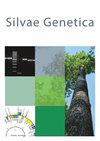雄性不育树种柳杉选育材料的遗传评价
IF 1
4区 农林科学
Q3 FORESTRY
引用次数: 0
摘要
摘要:目前,日本新泻县正在对日本柳杉(Cryptomeria japonica)雄性不育基因进行金字塔化。这是将金字塔育种应用于森林树木的第一次尝试。由于雄性不育的育种材料有限,在金字塔育种过程中必须特别注意增加遗传亲缘关系,尽量避免近交抑制的影响。本研究基于新泻县雄性不育个体(n = 6)的246个全基因组SNP标记和标记辅助选择产生的两个雄性不育基因(以下简称“双杂合”)的双杂合个体(n = 124)的遗传亲缘性进行了估计。新潟县同一地区雄性不育个体间的两两相关估计较低(- 0.01±0.08,平均值±标准差),表明即使利用这些雄性不育个体的F1进行人工杂交,也几乎不会产生负面影响。另一方面,本研究双异性个体的亲缘关系高于理论亲缘值,因为在人工杂交中使用亲缘关系稍高的个体作为亲本。然而,双异性恋个体的两两亲缘关系存在较大差异。这一结果表明,在利用有限的雄性不育个体的育种材料生产双人染色体时,利用一对亲缘关系较低的双异性染色体进行人工杂交,可以避免近交抑制的不利影响。继续选择新的雄性不育育种材料也很重要。本文章由计算机程序翻译,如有差异,请以英文原文为准。
Genetic evaluation of Cryptomeria japonica breeding materials for male-sterile trees
Abstract Pyramiding of male-sterile genes in Cryptomeria japonica is currently being carried out in Niigata prefecture, Japan. This is the first attempt to apply pyramid breeding to forest trees. As the breeding materials for male sterility are limited, special attention must be given to increased genetic relatedness in the process of pyramid breeding to avoid the effects of inbreeding depression as much as possible. In this study, we estimated genetic relatedness based on 246 genome-wide SNP markers for male-sterile individuals in Niigata Prefecture (n = 6) and individuals doubly heterozygous for two male-sterile genes (hereafter referred to as “double-hetero”) produced by marker- assisted selection (n = 124). The pairwise relatedness estimates between male-sterile individuals selected from the same area in Niigata Prefecture were low (−0.01 ± 0.08, mean ± standard deviation), suggesting that there will be almost no negative effects even if the F1 of these male-sterile individuals is used for artificial crossing. On the other hand, the pairwise relatedness between double-hetero individuals in this study was higher than the theoretical relatedness values, as individuals with the slightly higher relatedness were used as parents in artificial crossings. However, there was a large variance in pairwise relatedness for double-hetero individuals. This result suggested that it may be possible to avoid the adverse effects of inbreeding depression by using a pair of double-heteros with lower relatedness for artificial crossing, when we produce a double-homo using the limited breeding materials of male- sterile individuals. It will also be important to continue additional selection of new breeding material for male sterility.
求助全文
通过发布文献求助,成功后即可免费获取论文全文。
去求助
来源期刊

Silvae Genetica
农林科学-林学
CiteScore
2.20
自引率
10.00%
发文量
10
审稿时长
3 months
期刊介绍:
Silvae Genetica is an international peer reviewed journal with more than 65 year tradition and experience in all fields of theoretical and applied Forest Genetics and Tree breeding. It continues "Zeitschrift für Forstgenetik und Forstpflanzenzüchtung" (Journal of Forest Genetics and Forest Tree Breeding) founded by W. LANGNER in 1951.
 求助内容:
求助内容: 应助结果提醒方式:
应助结果提醒方式:


